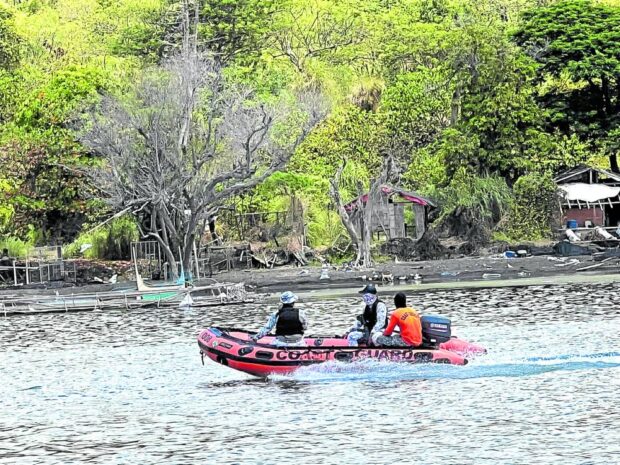Classes in 2 Batangas towns suspended due to Taal vog

OFF-LIMITS Philippine Coast Guard personnel patrol Taal Lake on June 3 to ensure that no one will enter Taal Volcano Island, or Pulo, in Batangas province, as the volcano shows signs of unrest. Gas emitted by the volcano resulted in the formation of volcanic smog or vog that has reached lakeshore communities. —PHOTO COURTESY OF THE TALISAY MUNICIPAL DISASTER RISK REDUCTION and MANAGEMENT COUNCIL
LUCENA CITY — Due to Taal Volcano’s continuous emission of volcanic sulfur dioxide (SO2) gas, in-person classes in public and private schools in the towns of Agoncillo and Talisay in Batangas province were suspended to ensure the safety of students and teachers.
Agoncillo Mayor Cinderella Reyes issued the class suspension on Thursday after meeting with other local officials as the town continued to experience “vog,” or volcanic smog.
Vog consists of fine droplets containing acidic volcanic gas that could cause irritation to the eyes and throat and be harmful to people with respiratory illnesses.
Schools in the town were ordered to temporarily shift to online or modular classes.
In Talisay, the suspension of classes in public and private schools started on Friday, Mayor Nestor Natanauan said.
Agoncillo and Talisay are among the localities that surround the lake, along with the towns of Laurel, Sta. Teresita, San Nicolas, Alitagtag, Cuenca, Balete and Mataasnakahoy, and the cities of Tanauan and Lipa, all in Batangas province. So far, only the two towns have issued the class suspension order.
Preventive measures
Health authorities in all the localities surrounding the volcano reminded their residents to wear face masks, preferably N-95, when going out of the house for protection against SO2 plumes from the volcano.
In its 5 a.m. bulletin on Friday, the Philippine Institute of Volcanology and Seismology (Phivolcs) reported that the volcano emitted 2,941 tonnes of SO2 over the past 24 hours that rose to 3,000 meters above Taal Volcano Island.
The SO2 emission was lower than the 7,680 tonnes recorded on Wednesday but the “ongoing degassing activity” at Taal Volcano has caused the formation of “significant” amount of vog over Taal Volcano and its surrounding areas, the Phivolcs noted.
The Phivolcs also warned on Wednesday that “acid rain could occur during periods of rainfall and volcanic gas emission over areas where the plume disperses, causing damage to crops and affecting the metal roofs of houses and buildings.”